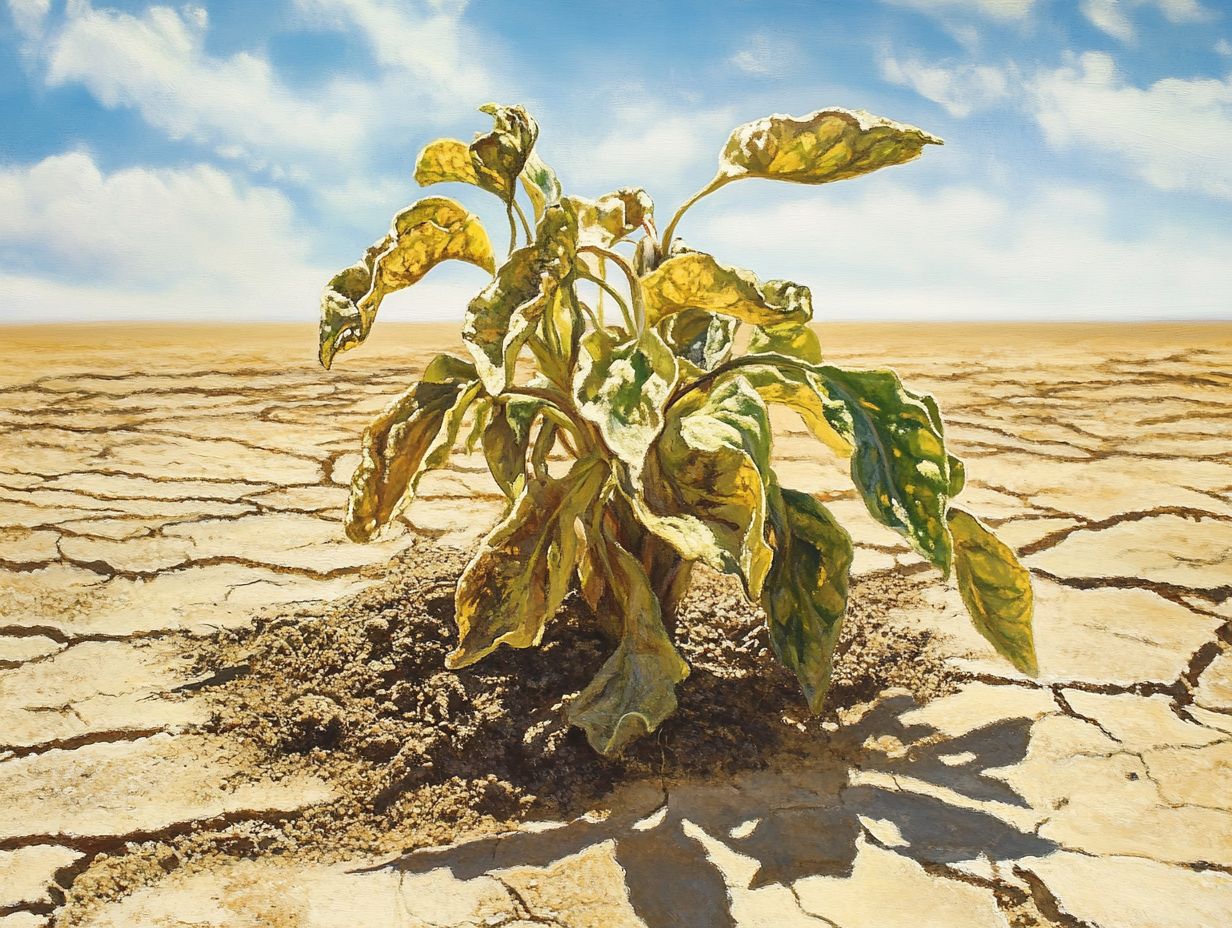Signs of Stress in Drought-Resistant Plants
In a time when water scarcity poses a significant challenge, grasping the importance of drought-resistant plants and trees is crucial for sustainable gardening and landscaping.
These hardy plants are champions of water conservation and can thrive in tough conditions. However, even the toughest among them may exhibit signs of stress. This article delves into the significance of drought resistance, uncovers the common symptoms of stress in these plants, and presents effective care techniques to keep them healthy and vibrant.
By adopting best practices, you can help these resilient companions flourish, even in the most challenging environments.
Contents
- Key Takeaways:
- The Importance of Drought-Resistant Plants
- Common Signs of Stress in Drought-Resistant Plants
- How to Help Stressed Drought-Resistant Plants
- Preventing Stress in Drought-Resistant Plants
- Frequently Asked Questions
- What are some common signs of stress in drought-resistant plants?
- How can I tell if my drought-resistant plant is experiencing stress?
- What are some factors that can cause stress in drought-resistant plants?
- What should I do if I notice signs of stress in my drought-resistant plant?
- Can drought-resistant plants die from stress?
- How can I prevent stress in my drought-resistant plants?
Key Takeaways:
Drought-resistant plants are essential for sustainable gardening. Here s why:
- Drought-resistant plants are crucial for maintaining a healthy and sustainable environment.
- Signs of stress in these plants can manifest in various ways, but with proper identification and care, it can be prevented.
- Proper care and maintenance techniques, along with preventative measures, are key in ensuring the well-being of drought-resistant plants.
The Importance of Drought-Resistant Plants
Drought-resistant plants are essential for maintaining ecological balance, especially as climate change intensifies drought conditions in regions like Alabama. These remarkable plants are uniquely adapted to flourish in low-moisture environments.
Their deep root systems enable them to tap into water sources beneath the soil. This ability also offers vital benefits such as moisture retention. It minimizes the need for frequent watering and supports the survival of established trees. Furthermore, it enhances the overall health of your garden.
Why Drought-Resistance is Essential
Drought resistance is essential in today s shifting climate. It plays a crucial role in reducing the adverse effects of drought on both urban and rural ecosystems. By cultivating plants that thrive during prolonged dry spells, you can enhance your community s water conservation efforts and foster healthier landscapes.
Drought-resistant plants often need less irrigation. This conservation allows you to save precious water resources and ease the burden on local supplies. Integrating such species into your gardens and public spaces supports biodiversity and helps create resilient ecosystems that are less vulnerable to extreme weather fluctuations.
Emphasizing sustainable practices like organic gardening and permaculture techniques (a method of gardening that works with nature) can further bolster ecosystem resilience. This ensures that both flora and fauna can thrive even in increasingly arid conditions.
Common Signs of Stress in Drought-Resistant Plants
Act now to recognize the signs of stress in your plants. Recognizing these signs is essential for effective care, especially during extreme weather conditions. You may notice symptoms like wilting, yellowing leaves, and leaf drop, which all indicate that your plants are struggling.
Being attentive to these signs will enable you to provide the necessary care and support they need to thrive.
Identifying Symptoms and Causes

Identifying the symptoms and causes of stress in drought-resistant plants is crucial for their longevity. You might notice visible signs like wilting leaves or discolored foliage, which often point to deeper issues. Understanding stress signs in plants can help you address these problems effectively.
If you’re dealing with root loss due to poor drainage or soil compaction, your plant’s ability to absorb moisture and nutrients can suffer significantly. This can lead to noticeable stress. Pests and diseases may target the roots or stems, manifesting symptoms that can seem unrelated at first.
Furthermore, environmental factors such as excessive heat, unpredictable rainfall, or nutrient-deficient soil can amplify these symptoms, creating a vicious cycle that endangers your plant’s health and survival.
How to Help Stressed Drought-Resistant Plants
To assist stressed drought-resistant plants, you should implement effective care and maintenance techniques. Strategies like deep watering and mulching can significantly enhance moisture retention in the soil, ensuring these resilient plants thrive even in challenging conditions.
Effective Care and Maintenance Techniques
Effective care and maintenance techniques are crucial for ensuring the survival of drought-resistant plants. Understanding their water requirements and utilizing their deep roots to access moisture is essential.
A carefully planned watering schedule is vital for achieving the best results. Allowing the soil to dry between watering sessions encourages deeper root growth as the plants search for moisture. Incorporating mulching techniques helps regulate soil temperature and prevent evaporation, significantly enhancing moisture retention.
Consider tailored irrigation strategies, such as drip irrigation, a watering system that delivers water directly to the soil. This method minimizes wastage while meeting the specific needs of these resilient species. By adopting these practices, you promote healthy growth and contribute to a sustainable gardening approach.
Preventing Stress in Drought-Resistant Plants
To prevent stress in drought-resistant plants, adopt best practices that foster robust root systems and effective stress management. This method helps your plants thrive, even in tough conditions!
Best Practices for Maintaining Healthy Plants

Implementing best practices for maintaining healthy drought-resistant plants involves mastering effective soil management, strategic watering, and vigilant monitoring for pests and diseases.
Enrich the soil with organic matter like compost and mulch to significantly improve its structure and enhance its water retention capabilities. This creates an environment where roots can thrive.
Utilize efficient watering techniques, such as drip irrigation, to ensure your plants receive consistent moisture without waste, promoting the development of deep, robust root systems.
Integrating pest management strategies, such as introducing beneficial insects or using natural repellents, protects against harmful pests while fostering a balanced ecosystem. This approach contributes to the resilience and vitality of your plants, ensuring they flourish in drought conditions.
Frequently Asked Questions
What are some common signs of stress in drought-resistant plants?
Wondering how to spot the signs of stress in your plants? Here are some common indicators:
- Wilting or drooping leaves
- Yellowing or browning of leaves
- Stunted growth
- Leaf curling
How can I tell if my drought-resistant plant is experiencing stress?
You can assess if your plant is experiencing stress by closely monitoring its appearance and behavior. Look for changes in leaf color, shape, and size. Additionally, pay attention to how the plant responds to watering and if it shows signs of slowing growth.
What are some factors that can cause stress in drought-resistant plants?

Aside from lack of water, factors that can cause stress in drought-resistant plants include:
- Extreme temperatures
- Poor soil quality
- Pests or diseases
What should I do if I notice signs of stress in my drought-resistant plant?
If you notice signs of stress, the first step is to ensure your plant is receiving enough water. If it is, consider other factors that may be causing stress and address them accordingly. Consulting a gardening expert for further advice is also a wise option.
Can drought-resistant plants die from stress?
Drought-resistant plants are more resilient to stress, but they can still die if the stress becomes too severe and is not addressed. It’s crucial to closely monitor these plants and recognize the signs of overwatering to ensure their survival.
How can I prevent stress in my drought-resistant plants?
To prevent stress, ensure your plants are planted in well-draining soil and receiving the appropriate amount of water for their specific needs. Mulching can also help retain moisture in the soil. Regularly inspect and care for your plants to catch potential stressors early on.
Don t wait! Start implementing these practices today to keep your plants thriving!






